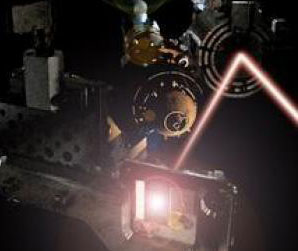Experimental set-up at the free-electron laser FLASH at DESY used to discover the new state of matter. (Credit: Image courtesy of University of Oxford)

An international team of scientists from 20 institutes including HASYLAB/DESY, led by Oxford University researchers, discovered an exceptional behavior of aluminium. They observed for the first time saturable absorption of an L-shell transition in aluminium using record intensities over 1016W cm-2 at a photon energy of 92 eV. The measurements were performed at FLASH at DESY.
The authors assume, that immediately after the soft X-ray pulses of the FEL has passed the thin piece of aluminium foil, the sample is in an exotic state where all of the aluminium atoms have an L-shell hole. The valence band has approximately a 9 eV temperature, whereas the atoms are still on their crystallographic positions. Subsequently to this process, Auger decay heats the material to the warm dense matter regime, at around 25 eV temperatures. The method is ideal to study homogeneous warm dense matter, highly relevant to planetary science, astrophysics and inertial confinement fusion.
(....from paper and press releases)
The results were published online: Bob Nagler et al. 'Turning solid aluminium transparent by intense soft X-ray photoionization', Nature Physics DOI: 10.1038/NPHYS1341 (26 July 2009 )
Transparent aluminium (for visible light) plays also a role in 'science fiction'. It is on the list of 'Star trek' materials, which is a list of fictional materials from the science fiction universe of this entertainment series. (....from Wikipedia)
| Further Information |





